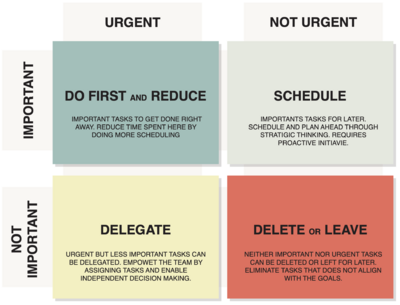The Eisenhower Decision Matrix
Management activities focus on the means of meeting project objectives, such as having effective processes, planning, coordinating, measuring, and monitoring work, among others. [1] Prioritizing work tasks in a project, program, or portfolio is crucial in order to manage and coordinate time and resources.
Dwight D. Eisenhower, 34th President of the United States from 1953 until 1961 invented the world-famous Eisenhower principle, describing how to prioritize work tasks by urgency and importance.[2] The principle is described in an Urgent-Important Matrix, also known as the Eisenhower Decision Matrix. Each quadrant guides decisions and acts of prioritization by comparing tasks to their value and alignment with goals. Therefore, establishing goals before achieving prioritization is paramount in order to use the Eisenhower Matrix effectively.[3] The goal of this prioritization is to avoid crisis situations by planning for the future, making tasks more manageable, helping delegate more, and avoiding wasting time on inconsequential tasks.[3]
The prioritization tool is relevant to the PEOPLE section of Project, Program, and Portfolio management. Specifically focusing on self-management for the individual. The capability for the individual people in a group or team to manage their work, motivation, focus, etc is fundamental for the outcome of the overall project, program, or portfolio. Self-management, also known as self-regulation, is the ability to control and redirect disruptive feelings and impulses. It is the ability to think before acting, suspending snap judgments, and impulsive decisions.[1]
The goal is to make decisions quickly while engaging the diverse knowledge of a group in an inclusive and respectful manner. In the end, the deciding authority, whether an individual or a group, makes a decision based on the presented analysis and with consideration for stakeholder expectations.[1]
Contents |
Project, Program, and Portfolio Management
- Time management
- Productivity
- Value-added work
The Eisenhower Decision Matrix
Guidance on how to use the tool and when it is applicable.
1. Quadrant
Do first, the urgent and important tasks.
2. Quadrant
Schedule, what needs to be done, and when.
3. Quadrant
delegate, tasks that are urgent but not important.
4. Quadrant
Delete or leave for later, things that are neither important nor urgent.
Limitations
What can it not do? Under what circumstances should it be used, and when not? How does it compare to the “status quo” of the standards – is it part of it, or does it extend them?
Annotated Bibliography
Summation and outline on the relevance of each reference to the topic.
References
- ↑ 1.0 1.1 1.2 Project Management: A guide to the Project Management Body of Knowledge (PMBOK guide), 7th Edition (2021).
- ↑ 2.0 2.1 Eisenhower. (2017, February 7) The Eisenhower Matrix: Introduction & 3-Minute Video Tutorial., Retrieved February 08, 2022, from, Link: https://www.eisenhower.me/eisenhower-matrix/
- ↑ 3.0 3.1 3.2 Bansal, V. (2021, May 19). Eisenhower Matrix: How to Prioritise and Master Productivity. TechTello. Retrieved February 08, 2022, from, Link: https://www.techtello.com/eisenhower-productivity-matrix/
